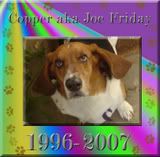Encouraging Article on half-body radiation treatment
I found the following article on half-body radiation:
J Vet Intern Med. 2004 Sep-Oct;18(5):703-9.
Chemotherapy followed by half-body radiation therapy for canine lymphoma.
Williams LE, Johnson JL, Hauck ML, Ruslander DM, Price GS, Thrall DE.
Department of Clinical Sciences, Veterinary Teaching Hospital, College of Veterinary Medicine, North Carolina State University, Raleigh, NC 27606, USA. laurel_williams@ncsu.edu
A protocol of induction chemotherapy followed by half-body radiation therapy for treatment of lymphoma was used in 94 dogs. Seventy-three (78%) dogs achieved complete remission. Substage (P = .011) and phenotype (P = .015) were identified as predictors of complete remission rate. Of these, 52 dogs received half-body irradiation. Cranial and caudal halves received a total dose of 8.0 Gy, given in 2 fractions of 4.0 Gy on consecutive days with cobalt-60 photons and a 3-week interval between halves. Median 1st remission for these dogs was 311 days. Anemia was identified as the only predictor for length of 1st remission (P = .024). Toxicoses after half-body irradiation generally were mild and infrequent and included myelosuppression and gastrointestinal signs. Thirty-one dogs relapsed and 20 resumed treatment with induction followed by maintenance chemotherapy. Seventeen (85%) dogs achieved a 2nd complete remission. Median overall remission for all 52 dogs was 486 days. Results of this study suggest that half-body radiation therapy after induction chemotherapy is well tolerated and might increase remission duration compared with conventional protocols that use chemotherapy alone, but this increase might not be long enough to be clinically relevant or to justify application of the method described herein.
J Vet Intern Med. 2004 Sep-Oct;18(5):703-9.
Chemotherapy followed by half-body radiation therapy for canine lymphoma.
Williams LE, Johnson JL, Hauck ML, Ruslander DM, Price GS, Thrall DE.
Department of Clinical Sciences, Veterinary Teaching Hospital, College of Veterinary Medicine, North Carolina State University, Raleigh, NC 27606, USA. laurel_williams@ncsu.edu
A protocol of induction chemotherapy followed by half-body radiation therapy for treatment of lymphoma was used in 94 dogs. Seventy-three (78%) dogs achieved complete remission. Substage (P = .011) and phenotype (P = .015) were identified as predictors of complete remission rate. Of these, 52 dogs received half-body irradiation. Cranial and caudal halves received a total dose of 8.0 Gy, given in 2 fractions of 4.0 Gy on consecutive days with cobalt-60 photons and a 3-week interval between halves. Median 1st remission for these dogs was 311 days. Anemia was identified as the only predictor for length of 1st remission (P = .024). Toxicoses after half-body irradiation generally were mild and infrequent and included myelosuppression and gastrointestinal signs. Thirty-one dogs relapsed and 20 resumed treatment with induction followed by maintenance chemotherapy. Seventeen (85%) dogs achieved a 2nd complete remission. Median overall remission for all 52 dogs was 486 days. Results of this study suggest that half-body radiation therapy after induction chemotherapy is well tolerated and might increase remission duration compared with conventional protocols that use chemotherapy alone, but this increase might not be long enough to be clinically relevant or to justify application of the method described herein.



0 Comments:
Post a Comment
<< Home